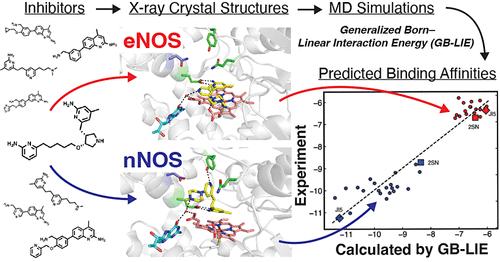线性相互作用能法在一氧化氮合成酶结构型抑制剂设计中的应用
IF 5.3
2区 化学
Q1 CHEMISTRY, MEDICINAL
引用次数: 0
摘要
神经元一氧化氮合酶(nNOS)过量产生一氧化氮与多种神经病变有关。因此,抑制 nNOS 是一个理想的治疗目标,同时避免抑制内皮 NOS(eNOS),因为它在维持心血管张力方面起着至关重要的作用。由于所有哺乳动物 NOS 异构体的活性位点结构非常相似,因此设计出对 nNOS 而非 eNOS 具有高度特异性的抑制剂具有挑战性。自由能扰动(FEP)和热力学整合(TI)等计算方法为合理的药物设计提供了极具吸引力的途径,但这些方法在 NOS 上的应用受到了一些挑战的阻碍,包括如何正确处理具有不同结构的高电荷抑制剂以及计算费用。为了解决这些问题,我们提出了一种将连续介质广义天生(GB)溶剂模型与线性相互作用能(LIE)计算相结合的简化方法。我们的方法与针对哺乳动物 NOS 异构体(mNOS)的带电抑制剂的实验数据非常吻合。我们的研究结果凸显了 GB-LIE 方法的实用性,它是筛选 NOS 抑制剂以及其他具有带电活性位点和多种抑制剂结构的潜在蛋白质靶点的有效工具。本文章由计算机程序翻译,如有差异,请以英文原文为准。

Application of the Linear Interaction Energy Method to Nitric Oxide Synthase Structure-Based Inhibitor Design
The overproduction of nitric oxide by neuronal nitric oxide synthase (nNOS) is associated with several neuropathological conditions. As a result, inhibition of nNOS is a desirable therapeutic goal while avoiding the inhibition of endothelial NOS (eNOS) given its essential role in maintaining cardiovascular tone. Designing inhibitors with high specificity for nNOS over eNOS is challenging given the close similarity in the active site structure of all mammalian NOS isoforms. Computational methods like free energy perturbation (FEP) and thermodynamic integration (TI) offer attractive avenues for rational drug design, but application of these methods to NOS is hindered by several challenges, including proper handling of highly charged inhibitors with diverse structures as well as computational expense. To address these issues, we present a simplified approach combining continuum dielectric generalized born (GB) solvent models with linear interaction energy (LIE) calculations. Our method demonstrates excellent agreement with experimental data for charged inhibitors targeting mammalian NOS isoforms (mNOS). Our results highlight the utility of the GB-LIE method as a promising tool for screening NOS inhibitors and potentially other protein targets with charged active sites and diverse inhibitor structures.
求助全文
通过发布文献求助,成功后即可免费获取论文全文。
去求助
来源期刊
CiteScore
9.80
自引率
10.70%
发文量
529
审稿时长
1.4 months
期刊介绍:
The Journal of Chemical Information and Modeling publishes papers reporting new methodology and/or important applications in the fields of chemical informatics and molecular modeling. Specific topics include the representation and computer-based searching of chemical databases, molecular modeling, computer-aided molecular design of new materials, catalysts, or ligands, development of new computational methods or efficient algorithms for chemical software, and biopharmaceutical chemistry including analyses of biological activity and other issues related to drug discovery.
Astute chemists, computer scientists, and information specialists look to this monthly’s insightful research studies, programming innovations, and software reviews to keep current with advances in this integral, multidisciplinary field.
As a subscriber you’ll stay abreast of database search systems, use of graph theory in chemical problems, substructure search systems, pattern recognition and clustering, analysis of chemical and physical data, molecular modeling, graphics and natural language interfaces, bibliometric and citation analysis, and synthesis design and reactions databases.

 求助内容:
求助内容: 应助结果提醒方式:
应助结果提醒方式:


